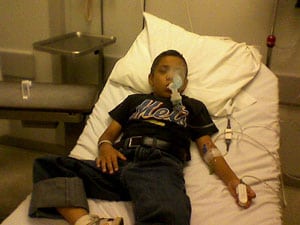- A boxer’s fracture is a misnomer because boxers don’t get them. This describes a fracture at the base of the small finger (5th metacarpal), often caused from poor form throwing a punch. If you take one hand and move the pinky finger portion of the palm (the metacarpal bone), you’ll notice how movable it is (i.e. unstable) compared with the same efforts on the index and middle fingers at the level of the palm, which is what should deliver the blow. A boxer’s fracture and a human bite together makes for a very bad day.
3) Is a human’s mouth really dirtier than a goat’s mouth?
- It’s correct to say the bacteria in a human’s mouth cause more disease.
4) Is a bite the same as a puncture wound
- The difference between a puncture wound and a laceration is you can identify the bottom (base) of the wound in a laceration, and you can’t in a puncture wound. Regarding bites: cats, snakes and the aforementioned Dracula are more likely to cause puncture wounds. Puncture wounds may or may not be caused by a bite (e.g. knife wounds are punctures).
5) I received a bite and didn’t get stitched up. Why?
- This could be for several reasons. Puncture wounds don’t receive stitches because you don’t want to seal off the infection. That’s a really good way to develop an abscess.
- Sometimes we will opt for ‘delayed closure’, waiting 3-5 days to ensure no infection has occurred before placing stitches.
- It’s really about the risk/benefit ratio. A laceration to a face is more likely to be repaired because of the risk of disfigurement and scarring, plus the face is a relatively low infection area anyway.
6) Why didn’t Dracula ever get Hepatitis or HIV?

- Even though Dracula’s the undead, one would think he’d be the world’s single greatest transmitter of both HIV and the blood transmitted forms of Hepatitis. HIV is viable for a while in dead tissue, but it can’t multiply, which would explain why Dracula doesn’t show signs of the diseases. On that note, I’m done.
Feel free to ask your SMA expert consultant any questions you may have on this topic.
Take the #72HoursChallenge, and join the community. As a thank you for being a valued subscriber to Straight, No Chaser, we’d like to offer you a complimentary 30-day membership at www.72hourslife.com. Just use the code #NoChaser, and yes, it’s ok if you share!
Order your copy of Dr. Sterling’s new books There are 72 Hours in a Day: Using Efficiency to Better Enjoy Every Part of Your Life and The 72 Hours in a Day Workbook: The Journey to The 72 Hours Life in 72 Days at Amazon or at www.72hourslife.com. Receive introductory pricing with orders!
Thanks for liking and following Straight, No Chaser! This public service provides a sample of what http://www.SterlingMedicalAdvice.com (SMA) and 844-SMA-TALK offers. Please share our page with your friends on WordPress, like us on Facebook @ SterlingMedicalAdvice.com and follow us on Twitter at @asksterlingmd.
Copyright © 2017 · Sterling Initiatives, LLC · Powered by WordPress










































































